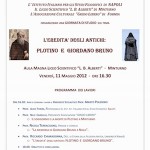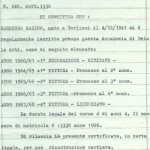Traduci





-
Articoli recenti
- Visita memorabile a Morra De Sanctis (Avellino) ed incontri imprevisti di umanità, di signorilità, di cultura, di memoria e di sensibilità civili
- L’uomo di Gerusalemme. Politica e Letteratura in Francesco De Sanctis nell’Italia dell’Ottocento
- La morte di Errico Amante
- Discorso di Trani, De Sanctis
- Circolare del 1861, De Sanctis
Antiche teorie della visione
LUCE DELL’OCCHIO, LUCE DELLA MENTE
Teorie della visione dalle origini all’anno 1000
Visual Science Before 1000: Summer Seminar, Boston University, July 2003
Department of Cognitive & Neural Systems
PREFACE
The roots of modern visual science date back to twentyfive centuries ago, back to the earliestGreek writers [1].
I am very grateful to Prof. Rucci for inviting me to present the subject of my studies in Italy. After being a principal for twenty years, I decided to put an end to my fighting against burocracy and go back to my studies.
Currently I am writing a book on the history of the theories of vision, from the origins to the year 1000 a.C. The visual experience is the result of a complex interaction among numerous components in the neural path from the eye to the brain. (I know that is an absolute novelty to you!?).
From the beginning of time, humans have tried to explain the complex process of vision. I think it is interesting to examine some of the ancient theories and compare them to our modern knowledge. The study of the human vision fascinates and frightens like a trip in an mysterious area only partially explored and still mysterious. The eye-brain system is an extremely complex one. The brain is a complex maze (or labyrinth ??): When it seems that the exit has been found, it becomes clear that we have just gone back to a “cul de sac”. It is a boundless universe wherein it is difficult to establish privileged research directions and whose areas, that appear as dead (or faded) from farther away, show themselves with the immensity of a new sky. Quite often we flatter ourselves that we have found new basic laws of the brain and that more detailed mathematical models can be built. But we only realize that such attempts are only a sign of our strong desire of new knowledge.
The research on the visual systems recalls to my memory the story of the drunk man anxiously looking for something in the ring of light of a street lamp during a night. A passer-by sees him and asks him what he was looking for. “My wallet”, the drunk man answers. The passer-by then starts looking for it in the ring of light. Since he cannot find anything, he asks the drunk man: “Where did you loose it?”. “Over there” he answers, pointing out a dark area. “And why are you looking for it here?” replies the passer-by. “Because there is no light over there”, the drunk man answers.
In the vision research, you have lit many lamps projecting oval cones of light on wide areas in semi or complete darkness. On such regions it is like you can read the writing of the ancient geographers “hic sunt leones”. We are often looking for our questions (and for answers) in the rings of light, and therefore wrong answers are found. But sometimes wallets lost in other moments or by other researches are found. Are the Tuesday seminars useful for exchanging the wallets lost and found by the members of your group?
Such state of the research activity is a limit, but, at the same time, it represents an irresistible attraction. From that point of view, even a research on the origins of the theories of vision is important. The study of the “errors” and of the “hypothesis” formulated in ancient times not only makes us aware of the long march of the main in all of the fields, but recalls us to an healthy doubt about the current positions, that need to remain open to the criticism and to the unfailing discussion. Today the ancient theories may seem strange, unsatisfying, or illogical, but we must remember that the theories of long ago were not based on today’s extensive experimental scientific data. Instead they were based on the conjecture and the observation of scholars.
Thanks to the knowledge generated by countless generations of scholars and scientists, using increasingly sophisticated tools in pursuit of scientific knowledge, your understanding of vision has come a very long way!
The awareness of the errors and of the discussions that have characterized the development of our knowledge about vision is helpful to better organize the problematic nodes. Such knowledge gives the awareness of belonging to a long story and such awareness helps in standing the efforts and the sacrifices that the research imposes. Furthermore, the ways the phenomena about vision have been described and interpreted in the various ages are fascinating. Besides the undoubted fascination characterizing the journey through the ancient theories of vision, a researcher, involved in the study of an infinitesimal portion of the retina or of the cortical tissue in the visual areas and enclosed in that small but complex universe, might loose the feeling of belonging to the “western science” and to feel like mislaid for a few moments.
The knowledge of belonging to a very long path, covered by philosophers and poets, as well as scientists, starting from the time of Homer, makes clear the motivation of the current efforts and of the numerous sacrifices.
A short scheme of the ancient eye anatomy.
[1] Polyak’s (1957) account of this history is especially recommended.
See also Borin, 1942, and Duke-Elder, 1958, 1961, 1968, 1971.
Pubblicato in Filosofia, Publications, Scienza, Visione
Contrassegnato Filosofia, Scienza, seminario
Lascia un commento



